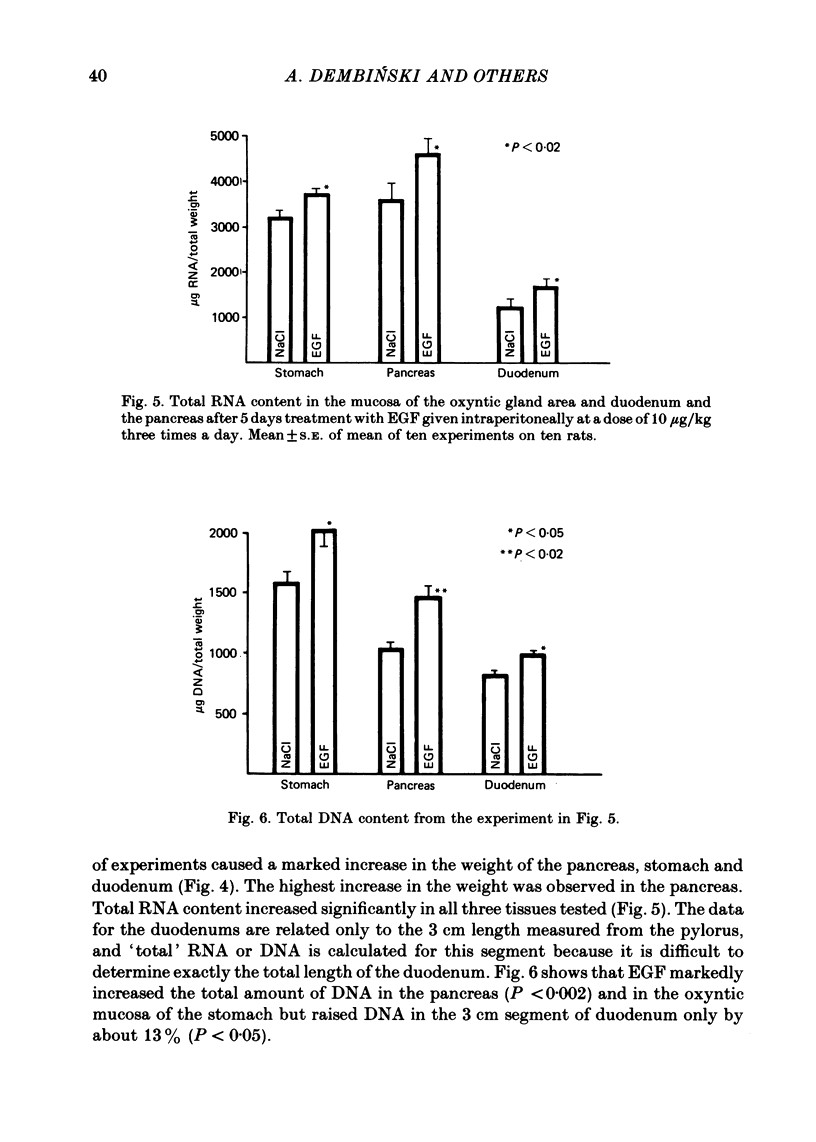Abstract
1. Epidermal growth factor (EGF) infused subcutaneously in a dose of 10 micrograms/kg . h but not 1 microgram/kg . h inhibited spontaneous gastric acid and pepsin secretion, whereas when given intragastrically in a dose of 10 micrograms/kg . h it failed to affect this secretion. 2. EGF injected intraperitoneally at 8 h intervals for 24 h significantly stimulated DNA synthesis in the gastroduodenal mucosa and the pancreas, whereas when administered intragastrically it stimulated DNA synthesis only in the gastroduodenal mucosa but not in the pancreas. 3. Chronic parenteral administration of EGF significantly increased the DNA and RNA contents of the gastroduodenal mucosa and the pancreas. 4. This study demonstrates that parenteral EGF is a potent inhibitor of gastric secretion and trophic agent for the gastroduodenal mucosa and pancreas, and that the gastric inhibitory and trophic effects of EGF are the results of two separate mechanisms.
Full text
PDF







Selected References
These references are in PubMed. This may not be the complete list of references from this article.
- BURTON K. A study of the conditions and mechanism of the diphenylamine reaction for the colorimetric estimation of deoxyribonucleic acid. Biochem J. 1956 Feb;62(2):315–323. doi: 10.1042/bj0620315. [DOI] [PMC free article] [PubMed] [Google Scholar]
- CERIOTTI G. Determination of nucleic acids in animal tissues. J Biol Chem. 1955 May;214(1):59–70. [PubMed] [Google Scholar]
- Cohen S., Taylor J. M. Epidermal growth factor: chemical and biological characterization. Recent Prog Horm Res. 1974;30(0):533–550. doi: 10.1016/b978-0-12-571130-2.50017-1. [DOI] [PubMed] [Google Scholar]
- Elder J. B., Williams G., Lacey E., Gregory H. Cellular localisation of human urogastrone/epidermal growth factor. Nature. 1978 Feb 2;271(5644):466–467. doi: 10.1038/271466a0. [DOI] [PubMed] [Google Scholar]
- Feldman E. J., Aures D., Grossman M. I. Epidermal growth factor stimulates ornithine decarboxylase activity in the digestive tract of mouse. Proc Soc Exp Biol Med. 1978 Dec;159(3):400–402. doi: 10.3181/00379727-159-40357. [DOI] [PubMed] [Google Scholar]
- Gregory H. Isolation and structure of urogastrone and its relationship to epidermal growth factor. Nature. 1975 Sep 25;257(5524):325–327. doi: 10.1038/257325a0. [DOI] [PubMed] [Google Scholar]
- Gregory H., Walsh S., Hopkins C. R. The identification of urogastrone in serum, saliva, and gastric juice. Gastroenterology. 1979 Aug;77(2):313–318. [PubMed] [Google Scholar]
- Hollenberg M. D., Gregory H. Human urogastrone and mouse epidermal growth factor share a common receptor site in cultured human fibroblasts. Life Sci. 1977 Jan 15;20(2):267–274. doi: 10.1016/0024-3205(77)90321-6. [DOI] [PubMed] [Google Scholar]
- Konturek S. J., Demitrescu T., Radecki T., Thor P., Pucher A. Effect of glucagon on gastric and pancreatic secretion and peptic ulcer formation in cats. Am J Dig Dis. 1974 Jun;19(6):557–564. doi: 10.1007/BF01072743. [DOI] [PubMed] [Google Scholar]
- LANE A., IVY A. C., IVY E. K. Response of the chronic gastric fistula rat to histamine. Am J Physiol. 1957 Aug;190(2):221–228. doi: 10.1152/ajplegacy.1957.190.2.221. [DOI] [PubMed] [Google Scholar]
- Savage C. R., Jr, Inagami T., Cohen S. The primary structure of epidermal growth factor. J Biol Chem. 1972 Dec 10;247(23):7612–7621. [PubMed] [Google Scholar]


